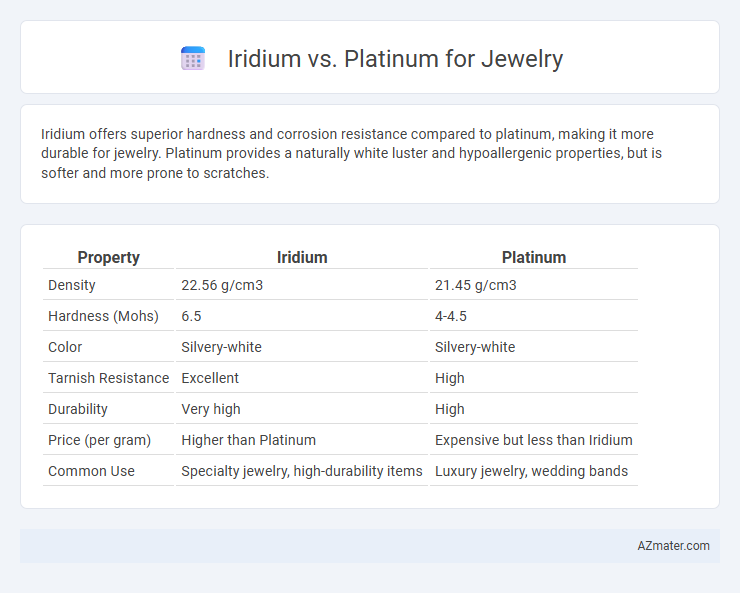Iridium offers superior hardness and corrosion resistance compared to platinum, making it more durable for jewelry. Platinum provides a naturally white luster and hypoallergenic properties, but is softer and more prone to scratches.
Table of Comparison
| Property | Iridium | Platinum |
|---|---|---|
| Density | 22.56 g/cm3 | 21.45 g/cm3 |
| Hardness (Mohs) | 6.5 | 4-4.5 |
| Color | Silvery-white | Silvery-white |
| Tarnish Resistance | Excellent | High |
| Durability | Very high | High |
| Price (per gram) | Higher than Platinum | Expensive but less than Iridium |
| Common Use | Specialty jewelry, high-durability items | Luxury jewelry, wedding bands |
Overview of Iridium and Platinum in Jewelry
Iridium and platinum are both rare, precious metals prized in jewelry for their durability and luster. Iridium, known for its exceptional hardness and corrosion resistance, is often alloyed with platinum to enhance strength and wearability in fine jewelry. Platinum offers a naturally white sheen, hypoallergenic properties, and a dense, malleable composition that makes it a popular choice for wedding bands and luxury pieces.
Physical Properties: Iridium vs Platinum
Iridium is significantly harder and more brittle than platinum, making it less malleable but highly resistant to scratches and wear in jewelry applications. Platinum, known for its ductility and excellent malleability, allows jewelers to create intricate designs without cracking, while maintaining a dense, heavy feel. Both metals boast exceptional corrosion resistance, though iridium's higher melting point and stiffness distinguish it as more durable in extreme conditions.
Durability and Wear Resistance Comparison
Iridium exhibits exceptional durability and corrosion resistance, making it one of the hardest metals used in jewelry, significantly outperforming platinum in scratch resistance and longevity. Platinum, while also highly durable and hypoallergenic, is softer and more prone to scratching and bending under daily wear compared to iridium. Jewelry crafted from iridium maintains its polish and structural integrity better over time, offering superior wear resistance especially for pieces exposed to frequent use.
Rarity and Value in the Market
Iridium and platinum are both rare precious metals, with platinum being more widely recognized and valued in the jewelry market due to its lustrous appearance and durability. Iridium ranks among the rarest metals on Earth, often found as a byproduct of platinum mining, but it is less commonly used in jewelry because of its hardness and brittleness. Market value for platinum consistently remains higher and more stable compared to iridium, driven by strong demand in fine jewelry and industrial applications.
Color and Aesthetic Differences
Iridium jewelry exhibits a naturally bright white color with a subtle metallic sheen that enhances its sleek, modern look, while platinum offers a slightly warmer, more subdued white tone with a soft, lustrous finish. The dense, reflective surface of iridium provides a mirror-like shine that resists tarnishing, making it ideal for contemporary jewelry designs. Platinum's aesthetic appeal lies in its rarity and smooth patina that develops over time, adding character and elegance to classic and vintage-style pieces.
Hypoallergenic Qualities and Skin Compatibility
Iridium and platinum are both hypoallergenic metals favored in jewelry for their excellent skin compatibility, making them ideal for sensitive skin. Iridium is a rare, dense metal resistant to corrosion and oxidation, minimizing the risk of allergic reactions. Platinum is widely renowned for its purity and durability, often containing minimal alloys, which enhances its hypoallergenic properties and reduces skin irritation.
Workability for Jewelry Designers
Iridium offers exceptional hardness and corrosion resistance, making it a durable option but challenging to work with due to its brittleness and high melting point. Platinum, known for its malleability and ductility, allows jewelry designers to craft intricate designs more easily while maintaining strength and longevity. The superior workability of platinum often makes it the preferred choice for fine jewelry requiring detailed craftsmanship and frequent adjustments.
Maintenance and Care Requirements
Iridium jewelry requires minimal maintenance due to its exceptional resistance to corrosion, tarnish, and scratching, making it ideal for long-lasting wear. Platinum, while also durable and resistant to tarnish, needs occasional polishing and professional cleaning to maintain its lustrous finish and repair surface scratches over time. Both metals benefit from gentle cleaning with mild soap and water, but iridium's superior hardness reduces frequent care needs compared to platinum.
Price Comparison: Iridium vs Platinum
Iridium's price in jewelry is generally lower than platinum due to its rarity and limited demand, making it a cost-effective alternative for durable and scratch-resistant pieces. Platinum commands higher prices because of its widespread use in premium jewelry, superior malleability, and established market value. Both metals are prized for their durability, but platinum's market premium reflects its prestige and traditional appeal in fine jewelry.
Choosing the Best Metal for Your Jewelry
Iridium and platinum both offer exceptional durability and a lustrous finish, making them popular choices for fine jewelry. Iridium is harder and more scratch-resistant, ideal for pieces requiring extra strength, while platinum provides a naturally white sheen and hypoallergenic properties favored in luxury designs. Consider iridium for long-lasting everyday wear and platinum for its classic elegance and comfort against sensitive skin when selecting the best metal for your jewelry.

Infographic: Iridium vs Platinum for Jewelry
 azmater.com
azmater.com